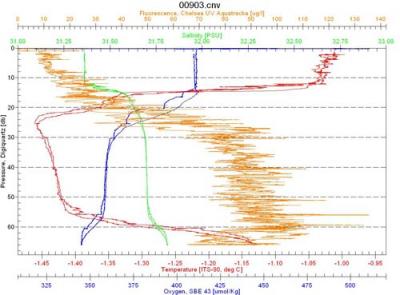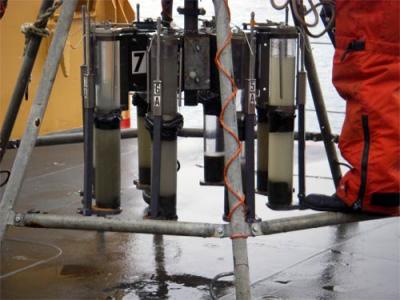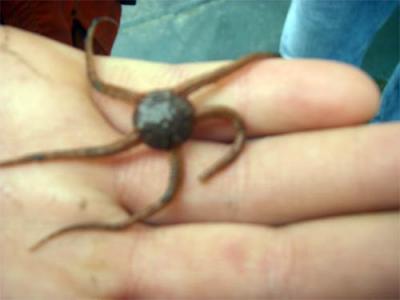I have been kept busy all day. In the morning, I went and checked in with Nancy and David Kachel and worked with the CTDA research tool that is submerged in the water to measure conductivity (salinity), temperature, and depth.. One parameter of the CTDA research tool that is submerged in the water to measure conductivity (salinity), temperature, and depth. was changed to help get better data. The PAR was activated which stands for Photosynthetic Active Radiation and is basically a small white ball mounted with sensors. It measures the visible spectrum that will aid in verifying the results of the fluorometer. As the CTDA research tool that is submerged in the water to measure conductivity (salinity), temperature, and depth. came up, there was a rush to go and get the water samples. The CTDA research tool that is submerged in the water to measure conductivity (salinity), temperature, and depth. is the core of all the science happening onboard the ship. It provides all basic physical components of seawater and also collects the water to be used for many of the scientists.

From looking above, you can see just how much information can be obtained from one cast of the CTDA research tool that is submerged in the water to measure conductivity (salinity), temperature, and depth.. Take a closer look at the salinity measurement (green). Notice the line and how it curves, this is called a halocline. Do you know why the salinity is lower at the surface? Send your answers to me at Ask the team.
I continued to follow the water samples to Cal Mordy, the chemist on the ship. He alone is responsible for nearly all the processing. Maggie and I helped him filter and set up samples to be analyzed. Cal tends to work crazy hours with long into the night and then sleeping for several hours during the day. If samples are collected while he is asleep, they are placed in the refrigerator and he then has to warm them to room temperature.
As Cal finished off the last of a set, he headed of for some well deserved sleep. I moved over to see about the multi-core group led by David Shull and Al Devol. They were just getting ready to send down the corer to get core samples and then cut them. Unfortunately, when it was brought up the bottom sediment was too hard and sandy to retain enough mud for core samples.

Even though it was a bad sample for mud cores, it was a great sample for biological studies. From the sample bottles, the mud was collected into a sieve by Geraldine McCormick-Ray, a specialist in benthic environments, and was then separated out. I stayed with Gerry and helped pick out all the small invertebrates found. We found brittle stars, barnacles, polychaetes, clams, and many others.



Comments